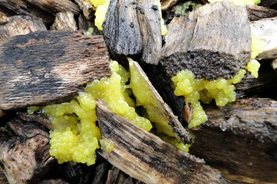Recent wet weather has led to an array of micro-organisms attacking the Plants for Bugs plots.

Our plots have come under attack! Yet again our near-native viburnum bushes have been hit with the
unusual bacterial infection that struck last year. Despite hefty cutting out when it first hit, the exceptionally wet winter and some wet spells this spring have given rise to lots of fresh infection on the new growth.
So again we have resorted to dramatic action and cut large swathes of the plants right back. The removed material will be incinerated.
There are no readily-available sprays that can be used on this sort of disease but I have been informed by our Plant Pathologist, Liz Beal, that erecting a rain shelter over the plants in early spring will keep the foliage dry and reduce infection. Now, where have those Plants for Bugs volunteers disappeared to? Perhaps if I could get them to stand over each viburnum with an umbrella, we should be ok… Hmm, guess that wouldn’t be too popular.

The rain has also encouraged the growth of a
beautiful yellow slime mould in our bark pathways. These will disappear almost as quickly as they appear.
On a similarly slippery note, we’ve had quite a bit of press coverage since the March Conference, in diverse papers and journals (here’s
one from the Independent). These offer a rather mixed (and not always very accurate) reflection and response to the event. However, I am not getting too drawn on the detail – after all, there will be plenty of opportunity to offer clear messages to the media once the first of the papers is published later this summer.

